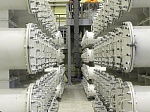19.06.2019
INFORMATION AND PUBLIC RELATIONS DEPARTMENT OF LENINGRAD NPP
The delivery of the ‘simulation zone’ for the 2nd VVER-1200 power block has started at the Leningrad NPP-2
The ‘simulation zone’ for the 2nd VVER-1200 power block is now being accepted at the Leningrad NPP-2 construction site. 83 out of 163 dummy assemblies have already been placed into the new plant’s new-fuel storage facility and are now undergoing acceptance control. The remaining assemblies will be delivered to the construction site in June and July. They will be ready for placement into the reactor in Q3 2019.
According to Vitaliy Godovykh, the head of nuclear materials control service at the nuclear safety and reliability department of the Leningrad NPP-2, it is the second time when the ‘simulation zone’ is used at the Leningrad NPP. Three years ago, it was used for the first time in order to conduct similar activities at the 1st VVER-1200 power block of the Leningrad NPP.
‘This set of dummy assemblies has shown its merit both at our site and at two power blocks of the Novovoronezh NPP. Following each use, the dummy assemblies are delivered to the Electrogorsk Research And Engineering Center On Nuclear Power Plants Safety where these assemblies are cleaned from surface contamination. They also undergo visual and instrumental control and re-examination. Repeated usage does not do any harm to the simulators, and they can be re-used following these procedures for any other pre-commissioning activities until a license for nuclear fuel upload into the reactor is obtained’, Mr. Godovykh explained.
A dummy assembly is a piece of equipment that full replicates the structure of regular fuel assemblies in terms of size, weight, and construction materials (except for nuclear fuel). When used in a simulation zone, their role is to do geometric modeling of the reactor core and to confirm the hydraulic properties of the reactor assembly during the cold and hot reactor trial. Those are also required for running transportation and processing operations using a refueling machine.
Reference:
Compared to the traditional VVER-1000 power blocks, the project for the 3+ generation Leningrad NPP power block has a number of advantages that considerably increase its economic parameters and safety standards. The capacity of the nuclear facility has been increased by 20%, from 1000 to 1200 megawatt; the designed life span of the core equipment has doubled and is now 60 years. In addition to that, this power block complies with the top international standards with regard to nuclear security. The Leningrad NPP-2 project serves as a reference for several international projects by the Rosatom State Corporation, such as the Belarusian NPP, the Paksh-2 NPP, the El Dabaa NPP, the Hanhikivi-1 NPP, etc.
The Leningrad NPP is the country’s first plant with RBMK-1000 reactors (uranium-graphite circuit-type reactor running on thermal neutrons). The decision that marked its construction was taken in September 1966 by a resolution of the Central Committee of the Communist Party of the USSR and the Council of Ministers No. 800-252. According to that document, the Leningrad NPP was supposed to become a core in a network of nuclear power plants with RBMK-1000 reactors that were supposed to produce a substantial share of electric power. The construction of the Leningrad NPP was going well, and by 1973 the first power block was fully erected. On December 23, 1973, following stable 72-hours’ operation at the capacity of 150 megawatt, the State Commission signed the acceptance certificate stating that the first power block of the Leningrad nuclear power plant is commissioned for pilot production.


 career
career Innovations
Innovations Projects
Projects INTERNATIONAL BUSINESS
INTERNATIONAL BUSINESS